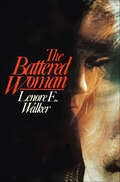- Table View
- List View
La batalla cultural: Reflexiones críticas para una Nueva Derecha
by Agustin LajeEl afamado escritor, politólogo, y conferencista Agustín Laje presenta La batalla cultural: Reflexiones críticas para una Nueva Derecha – un manifiesto que informará, animará y facultará a los &“guerrilleros culturales&” para no bajar los brazos en la batalla que sigue perjudicando a nuestras familias y a la sociedad en general.En el mundo contemporáneo, la sociedad y la cultura cambian a gran velocidad. La voluntad de dirigir esos cambios está en la base de las batallas culturales que hoy se viven en todas partes. Bien investigado y argumentado inteligentemente, este libro define el concepto de batalla cultural y muestra hasta qué punto la cultura ha llegado a ser el botín principal del poder, cómo se han desarrollado estas batallas desde los tiempos modernos hasta la actual posmodernidad y cómo enfrentarlas.En este libro, Agustín Laje:Explica qué es la batalla cultural, cómo darla, y cuales son su característicasAnaliza cómo la nueva izquierda entendió este fenómeno, frente a una derecha que menospreció el poder de la culturaExamina cómo entendió este fenómeno la nueva izquierda, frente a una derecha que menospreció el poder de la culturaPretende brindar las herramientas necesarias para el nacimiento de una nueva derechaEste libro está dirigido a: Las familias que son el principal blanco de ataque en este momento, que se sienten fragmentadas, amedrentadas y que quieren hacer algo más para convertirse en agentes de batalla culturalA los Jóvenes que cursan sus estudios y que entienden que en sus universidades cada vez hay menos educación y más adoctrinamientoA todo aquel que se preocupa por los asuntos políticos y mundiales de gran magnitud que crean conflictos en la sociedad&“La lucha política y la lucha cultural son las dos caras de una misma moneda. Si no hay política sin hegemonía, entonces tampoco hay política sin batalla cultural&”, dice Laje. &“La batalla cultural terminará mostrándose como la madre de todas las batallas.&”The Culture BattleFamed writer, political scientist, and lecturer Agustín Laje presents The Culture Battle: Critical Reflections for a New Right – a manifesto that will inform, encourage and empower the &“cultural guerrillas&” not to give up in the battle that continues to harm our families and society in general.In the contemporary world, society and culture are changing at great speed. The will to lead these changes is at the basis of the cultural battles that are being fought everywhere today. Well researched and intelligently argued, this book defines the concept of cultural battle and shows to what extent culture has become the main spoils of power, how these battles have developed from modern times to today's postmodernity and how to face them.In this book, Agustín Laje:Explains what the culture battle is, how to wage it, and what its characteristics areAnalyzes how the new left understood this phenomenon, in the face of a right wing that underestimated the power of cultureExamines how the new left understood this phenomenon, in the face of a right wing that underestimated the power of cultureAims to provide the necessary tools for the birth of a new right wing
Bath, 1680–1850: A Social History or A Valley of Pleasure, yet a Sink of Iniquity (Routledge Revivals)
by R. S. NealeFirst published in 1981, Bath, 1680–1850 reveals the changing structure of society and its social values as shown in the expansion of the city. The book examines the lives of men and women who lived in Bath and who, as consumers and producers, transformed it from a small Cotswold town built in the vernacular style, into a uniquely spacious Palladian city devoted to the well-being and leisure activities of the wealthy. In doing so, it explores how the changes in Bath emerged in response to the needs of commerce, industry, and its growing working class, and presents the city as a microcosm of the social transformation brought about by the development of capitalism in England. Bath, 1680–1850 will appeal to those with an interest in social and cultural history.
Bath and Beyond: The Social and Cultural World of the Georgian Assembly Room (Routledge Studies in Eighteenth-Century Cultures and Societies)
by Hillary Burlock Robin Eagles Tatjana LeBoffThis book re-examines spa and assembly culture as key venues for sociability in the eighteenth century.Focused chiefly on the eighteenth century, this book looks forward into the nineteenth and early twentieth centuries. While many of the chapters concern aspects of the city of Bath, the book stretches beyond Bath’s confines, taking in comparative British towns such as Tunbridge Wells, European spa towns, such as Nice, and the impact Bath had on spa towns in America. The chapters not only reconsider familiar themes such as the marriage market but also offer new insights into the architectural development of the city and the role of Masters of Ceremonies: the officials who oversaw Assembly Rooms’ rules and culture. There are also insights into the musical culture of spa towns and the varied backgrounds of the artists and performers. As places that attracted the wealthy and powerful, the book rounds off with consideration of Bath and other spa towns’ importance as centres of culture and diplomacy and of their place in the tourist industry.This accessibly written book appeals to a broad readership, including undergraduate and postgraduate students as well as academics and informed non-specialists interested in social and cultural history, British history, and modern history.
The Ba'th and the Creation of Modern Syria: Syria: Ba'th And The Creation Of Modern Syria (Routledge Library Editions: Syria)
by David RobertsThis book traces the development of modern Syria focusing on the contribution of the Ba’th party and Ba’thist ideology. It examines the roots of the Ba’th in the intellectual ferment of the 1940s and charts its growing influence on Syrian politics. Special attention is devoted to the crucial Sixth Congress of the Ba’th Party in 1963 and the key ideological document, the Muntalaqat, produced by Michel Aflaq. After 1963 the military became increasingly dominant until Hafiz al-Asad came to power in 1970. Since then the Party has been less dominant internally but Syria itself has established a pivotal position in regional affairs. The book concludes by reviewing the prospects for Syria after Asad and the potential for a Ba’thist revival.
Bathroom Battlegrounds: How Public Restrooms Shape the Gender Order
by Alexander K. DavisToday’s debates about transgender inclusion and public restrooms may seem unmistakably contemporary, but they have a surprisingly long and storied history in the United States—one that concerns more than mere "potty politics." Alexander K. Davis takes readers behind the scenes of two hundred years’ worth of conflicts over the existence, separation, and equity of gendered public restrooms, documenting at each step how bathrooms have been entangled with bigger cultural matters: the importance of the public good, the reach of institutional inclusion, the nature of gender difference, and, above all, the myriad privileges of social status. Chronicling the debut of nineteenth-century "comfort stations," twentieth-century mandates requiring equal-but-separate men’s and women’s rooms, and twenty-first-century uproar over laws like North Carolina’s "bathroom bill," Davis reveals how public restrooms are far from marginal or unimportant social spaces. Instead, they are—and always have been—consequential sites in which ideology, institutions, and inequality collide.
Bathsheba's Breast: Women, Cancer, and History
by James S. OlsonThe stories of women throughout the ages who have confronted breast cancer, from ancient times to the present.A Los Angeles Times Best Book of 2003 and Winner of the Association of American Publishers Professional and Scholarly Publishing Award for the History of Science"Breast cancer may very well be history's oldest malaise, known as well to the ancients as it is to us. The women who have endured it share a unique sisterhood. Queen Atossa and Dr. Jerri Nielsen—separated by era and geography, by culture, religion, politics, economics, and world view—could hardly have been more different. Born 2,500 years apart, they stand as opposite bookends on the shelf of human history. One was the most powerful woman in the ancient world, the daughter of an emperor, the mother of a god; the other is a twenty-first-century physician with a streak of adventure coursing through her veins. From the imperial throne in ancient Babylon, Atossa could not have imagined the modern world, and only in the driest pages of classical literature could Antarctica-based Jerri Nielsen even have begun to fathom the Near East five centuries before the birth of Christ. For all their differences, however, they shared a common fear that transcends time and space."—from Bathsheba's BreastIn 1967, an Italian surgeon touring Amsterdam's Rijks museum stopped in front of Rembrandt's Bathsheba at Her Bath, on loan from the Louvre, and noticed an asymmetry to Bathsheba's left breast; it seemed distended, swollen near the armpit, discolored, and marked with a distinctive pitting. With a little research, the physician learned that Rembrandt's model, his mistress Hendrickje Stoffels, later died after a long illness, and he conjectured in a celebrated article for an Italian medical journal that the cause of her death was almost certainly breast cancer.A horror known to every culture in every age, breast cancer has been responsible for the deaths of 25 million women throughout history. An Egyptian physician writing 3,500 years ago concluded that there was no treatment for the disease. Later surgeons recommended excising the tumor or, in extreme cases, the entire breast. This was the treatment advocated by the court physician to sixth-century Byzantine empress Theodora, the wife of Justinian, though she chose to die in pain rather than lose her breast. Only in the past few decades has treatment advanced beyond disfiguring surgery.In Bathsheba's Breast, historian James S. Olson—who lost his left hand and forearm to cancer while writing this book—provides an absorbing and often frightening narrative history of breast cancer told through the heroic stories of women who have confronted the disease, from Theodora to Anne of Austria, Louis XIV's mother, who confronted "nun's disease" by perfecting the art of dying well, to Dr. Jerri Nielson, who was dramatically evacuated from the South Pole in 1999 after performing a biopsy on her own breast and self-administering chemotherapy. Olson explores every facet of the disease: medicine's evolving understanding of its pathology and treatment options; its cultural significance; the political and economic logic that has dictated the terms of a war on a "woman's disease"; and the rise of patient activism. Olson concludes that, although it has not yet been conquered, breast cancer is no longer the story of individual women struggling alone against a mysterious and deadly foe.
Batman: Batman
by Matt YockeyABC's action-comedy series Batman (1966-68) famously offered a dual address in its wildly popular portayal of a comic book hero in a live action format. Children uncritically accepted the show's plots and characters, who were guided by lofty ideals and social values, while adults reacted to the clear parody of the values on display. In Batman, author Matt Yockey argues that the series served as a safe space for viewers to engage with changing attitudes about consumerism, politics, the Vietnam war, celebrity, race, and gender during a period when social meaning was increasingly contested in America. Yockey examines Batman's boundary pushing in four chapters. In "Bat-Civics," he analyzes the superhero as a conflicted symbol of American identity and considers the ways in which the Batman character parodied that status. Yockey then looks at the show's experimentation with the superhero genre's conservative gender and racial politics in "Bat-Difference" and investigates the significance of the show's choices of stars and guest stars in "Bat-Casting." Finally, he considers how the series' dual identity as straightforward crime serial and subversive mass culture text set it up for extratextual production in "Bat-Being." The superhero is a conflicted symbol of American identity--representing both excessive individualism and the status quo--making it an especially useful figure for the kind of cultural work that Batman undertook. Batman fans, from popular culture enthusiasts to television history scholars, will enjoy this volume.
Batman and the Joker: Contested Sexuality in Popular Culture (Routledge Focus on Gender, Sexuality, and Comics)
by Chris RichardsonThis cultural analysis of visual and narrative elements within Batman comics provides an important exploration of the ways readers and creators negotiate gender, identity, and sexuality in popular culture. Thematic chapters investigate how artists, writers, and fans engage with, challenge, and interpret gendered and sexual representations by focusing on one of the most popular and heated fictional rivalries ever inked: that of Batman and the Joker. The monograph provides critical insights into ways queer reading practices can open new forms of understanding that have generally remained implicit and unexplored in mainstream comics studies. This accessible and interdisciplinary approach to the Caped Crusader and the Clown Prince of Crime engages diverse fields of scholarship such as Comics Studies, Critical Theory, Cultural Studies, Gender Studies, Literature, Psychoanalysis, Media Studies, and Queer Theory.
Batman and the Multiplicity of Identity: The Contemporary Comic Book Superhero as Cultural Nexus (Routledge Advances in Comics Studies)
by Jeffrey A. BrownConcentrating primarily on contemporary depictions of Batman in the comic books, this book analyzes why Batman is so immensely popular right now in America and globally, and how the fictional Dark Knight reveals both new cultural concerns and longstanding beliefs about American values. The organizing premise is that while Batman is perceived as a very clearly defined character, he is open to a wide range of interpretations and depictions in the comics (what Henry Jenkins refers to as "multiplicities"), each of which allows access to different cultural issues. The idea of Batman functions as an anchoring point out of which multiple Batmen, or Batman-like characters, can occupy different positions: Grim Batman, Gay Batman, Female Batman, Black Batman, Cute Batman, and so on. Each iteration opens up a discussion of different cultural issues pertinent to modern society, such as sexuality, ethnicity, feminism and familial relationships.
Batman and the Shadows of Modernity: A Critical Genealogy on Contemporary Hero in the Age of Nihilism (Literary Criticism and Cultural Theory)
by Rafael Carrión-AriasThis book aims to study the Batman narrative, or Bat-narrative, from the point of view of its nodal relationship to modern narrative. To this end, it offers for the first time a new type of methodology adequate to the object, which delves both into materials scarcely studied in this context and well-known materials seen in a new light. This is a multidisciplinary work aimed at both the specialist and the global reader, bringing together comic studies, philosophical criticism, and literary criticism in a debate on the fate of our current global civilization.
Batman Saves the Congo: How Celebrities Disrupt the Politics of Development
by Alexandra Cosima Budabin Lisa Ann RicheyHow celebrity strategic partnerships are disrupting humanitarian space Can a celebrity be a &“disrupter,&” promoting strategic partnerships to bring new ideas and funding to revitalize the development field—or are celebrities just charismatic ambassadors for big business? Examining the role of the rich and famous in development and humanitarianism, Batman Saves the Congo argues that celebrities do both, and that understanding why and how yields insight into the realities of neoliberal development. In 2010, entertainer Ben Affleck, known for his superhero performance as Batman, launched the Eastern Congo Initiative to bring a new approach to the region&’s development. This case study is central to Batman Saves the Congo. Affleck&’s organization operates with special access, diversified funding, and significant support of elites within political, philanthropic, development, and humanitarian circuits. This sets it apart from other development organizations. With his convening power, Affleck has built partnerships with those inside and outside development, staking bipartisan political ground that is neither charity nor aid but &“good business.&” Such visible and recognizable celebrity humanitarians are occupying the public domain yet not engaging meaningfully with any public, argues Batman Saves the Congo. They are an unruly bunch of new players in development who amplify business solutions. As elite political participants, celebrities shape development practices through strategic partnerships that are both an innovative way to raise awareness and funding for neglected causes and a troubling trend of unaccountable elite leadership in North–South relations. Batman Saves the Congo helps illuminate the power of celebritized business solutions and the development contexts they create.
Batman Unauthorized: Vigilantes, Jokers, and Heroes in Gotham City
by Dennis O’Neil and Leah WilsonBatman Unauthorized explores Batman's motivations and actions, as well as those of his foes. Batman is a creature of the night, more about vengeance than justice, more plagued by doubts than full of self-assurance, and more darkness than light. He has no superpowers, just skill, drive and a really well-made suit. One of the most recognized superheroes ever created, Batman has survived through campy TV shows and films, through actors such as Adam West, Michael Keaton and Christian Bale. Batman Unauthorized: Vigilantes, Jokers, and Heroes in Gotham City covers expansive territory ranging from the silly to the solemn. Why is the Joker so good at pushing Batman's buttons? What does Batman's technology say about the times? Why are Batman's villains crazier than average? And why is Batman the perfect, iconic American hero?
Batos, Bolillos, Pochos, and Pelados: Class and Culture on the South Texas Border
by Chad Richardson Michael J. PisaniThis updated edition of the classic study examines life on the Texas-Mexico border, including the effects of NAFTA, drug violence, and immigration crises.Batos, Bolillos, Pochos, and Pelados offers an authoritative portrait of the people of the South Texas/Northern Mexico borderlands. First published in 1999, the book is now extensively revised and updated to cover developments since 2000, including undocumented immigration, the drug wars, race relations, growing social inequality, and the socioeconomic gap between Latinos and the rest of American society—issues of vital and continuing national importance.An outgrowth of the Borderlife Research Project conducted at the University of Texas Rio Grande Valley, Batos, Bolillos, Pochos, and Pelados uses the voices of several hundred Valley residents, collected by embedded student researchers and backed by the findings of sociological surveys, to describe the lives of migrant farmworkers, colonia residents, undocumented domestic servants, maquiladora workers, and Mexican street children. This wide-ranging study explores social, racial, and ethnic relations in South Texas among groups such as Latinos, Mexican immigrants, wealthy Mexican visitors, Anglo residents or tourists, and Asian and African American residents. With extensive firsthand material, the book addresses the future integration of Latinos into the United States.
Batos, Bolillos, Pochos, and Pelados: Class and Culture on the South Texas Border
by Chad Richardson Michael J. PisaniThis updated edition of the classic study examines life on the Texas-Mexico border, including the effects of NAFTA, drug violence, and immigration crises.Batos, Bolillos, Pochos, and Pelados offers an authoritative portrait of the people of the South Texas/Northern Mexico borderlands. First published in 1999, the book is now extensively revised and updated to cover developments since 2000, including undocumented immigration, the drug wars, race relations, growing social inequality, and the socioeconomic gap between Latinos and the rest of American society—issues of vital and continuing national importance.An outgrowth of the Borderlife Research Project conducted at the University of Texas Rio Grande Valley, Batos, Bolillos, Pochos, and Pelados uses the voices of several hundred Valley residents, collected by embedded student researchers and backed by the findings of sociological surveys, to describe the lives of migrant farmworkers, colonia residents, undocumented domestic servants, maquiladora workers, and Mexican street children. This wide-ranging study explores social, racial, and ethnic relations in South Texas among groups such as Latinos, Mexican immigrants, wealthy Mexican visitors, Anglo residents or tourists, and Asian and African American residents. With extensive firsthand material, the book addresses the future integration of Latinos into the United States.
Batos, Bolillos, Pochos, & Pelados
by Chad Richardson"This book demonstrates the richness of the interethnic mosaic characterizing the Valley of South Texas. . . . By giving voice to local residents, Professor Richardson has amassed a valuable stock of knowledge concerning life along the Texas-Mexican border that is sorely missing in the extant literature. " --Rogelio Saenz, Professor and Head of Sociology, Texas A&M University "The Valley of South Texas," a recent joke goes, "is a great place to live. It's so close to the United States. " Culturally, this borderland region is both Mexican and Anglo-American, and its people span the full spectrum, from a minority who wish to remain insulated within strictly Anglo or Mexican communities and traditions to a majority who daily negotiate both worlds. This fascinating book offers the fullest portrait currently available of the people of the South Texas borderlands. An outgrowth of the Borderlife Research Project conducted at the University of Texas-Pan American, it uses the voices of several hundred Valley residents, backed by the findings of sociological surveys, to describe the lives of migrant farm workers, colonia residents, undocumented domestic servants, maquila workers, and Mexican street children. Likewise, it explores race and ethnic relations among Mexican Americans, permanent Anglo residents, "Winter Texans," Blacks, and Mexican immigrants. From this firsthand material, the book vividly reveals how social class, race, and ethnicity have interacted to form a
The Battered Woman
by Lenore E. Walker"A major contribution to this subject. She is thorough, practical, compassionate, and authoritative. It is a reading must."--Phyllis Chesler
Battered Women and Feminist Lawmaking and the Struggle for Equality
by Elizabeth M. SchneiderThis book examines the pathbreaking legal process that has brought the pervasiveness and severity of domestic violence to public attention and has led the United States Congress, the Supreme Court, and the United National to address the problem.
Battered Women as Survivors (Routledge Library Editions: Domestic Abuse #3)
by Lee Ann HoffFirst published in 1990, this book is based on a field study of domestic abuse victims and their social network members. In a life history perspective, using values and network analysis, it uncovers the social context of a ‘secret’ crime against women and reveals the relationship between personal crisis and traditional attitudes toward women, marriage, the family, and violence. This book breaks new ground by redirecting attention beyond victim-blaming and the medicalization of violence to understanding domestic abuse victims as survivors who manage multiple crises despite public inattention to their plight. From analysis of the women’s struggles with violence and its aftermath, this book proposes a new crisis paradigm, which underscores the sociocultural aspects of crisis originating from violence. This book will be of interest to those studying social sciences, women’s studies, social work, health and mental health professions.
Battering States: The Politics of Domestic Violence in Israel
by Madelaine AdelmanBattering States explores the most personal part of people's lives as they intersect with a uniquely complex state system. The book examines how statecraft shapes domestic violence: how a state defines itself and determines what counts as a family; how a state establishes sovereignty and defends its borders; and how a state organizes its legal system and forges its economy. The ethnography includes stories from people, places, and perspectives not commonly incorporated in domestic violence studies, and, in doing so, reveals the transformation of intimate partner violence from a predictable form of marital trouble to a publicly recognized social problem.The politics of domestic violence create novel entry points to understanding how, although women may be vulnerable to gender-based violence, they do not necessarily share the same kind of belonging to the state. This means that markers of identity and power, such as gender, nationality, ethnicity, religion and religiosity, and socio-economic and geographic location, matter when it comes to safety and pathways to justice.The study centers on Israel, where a number of factors bring connections between the cultural politics of the state and domestic violence into stark relief: the presence of a contentious multinational and multiethnic population; competing and overlapping sets of religious and civil laws; a growing gap between the wealthy and the poor; and the dominant presence of a security state in people's everyday lives. The exact combination of these factors is unique to Israel, but they are typical of states with a diverse population in a time of globalization. In this way, the example of Israel offers insights wherever the political and personal impinge on one another.
Battering States: The Politics of Domestic Violence in Israel
by Madelaine AdelmanBattering States explores the most personal part of people's lives as they intersect with a uniquely complex state system. The book examines how statecraft shapes domestic violence: how a state defines itself and determines what counts as a family; how a state establishes sovereignty and defends its borders; and how a state organizes its legal system and forges its economy. The ethnography includes stories from people, places, and perspectives not commonly incorporated in domestic violence studies, and, in doing so, reveals the transformation of intimate partner violence from a predictable form of marital trouble to a publicly recognized social problem. The politics of domestic violence create novel entry points to understanding how, although women may be vulnerable to gender-based violence, they do not necessarily share the same kind of belonging to the state. This means that markers of identity and power, such as gender, nationality, ethnicity, religion and religiosity, and socio-economic and geographic location, matter when it comes to safety and pathways to justice. The study centers on Israel, where a number of factors bring connections between the cultural politics of the state and domestic violence into stark relief: the presence of a contentious multinational and multiethnic population; competing and overlapping sets of religious and civil laws; a growing gap between the wealthy and the poor; and the dominant presence of a security state in people's everyday lives. The exact combination of these factors is unique to Israel, but they are typical of states with a diverse population in a time of globalization. In this way, the example of Israel offers insights wherever the political and personal impinge on one another.
The Battle Against Poverty (Routledge Library Editions)
by B RodgersFirst Published in 2005. Routledge is an imprint of Taylor & Francis, an informa company.
The Battle Against Slavery: The Untold Story of How a Group of Yorkshire Radicals Began the War to End the Slave Trade
by Paul L. DawsonOn 13 December 1776, the Rev. William Turner preached the first avowedly anti-slavery sermon in the North of England. Copies of his sermon were distributed far and wide – in so doing, he had fired the first shot in the battle to end slavery had begun. Four years later, Rev. Turner, members of his congregation and the Rev. Christopher Wyvill founded ‘The Yorkshire Association’ to agitate for political and social reform. The Association sought universal suffrage, annual parliaments and the abolition of slavery. In the West Riding, despite furious opposition, by 1783 nearly 10,000 signatures were collected in support of the aims of the Association. Slavery, or rather its abolition, was now on the political agenda. The Battle Against Slavery charts the story of a group of West Riding radicals in their bid to abolish slavery both in the United Kingdom and abroad. Such became the influence of this group, whose Unitarian beliefs were illegal in Britain, that the general election of 1806 in Yorkshire was fought on an abolitionist platform. At a time when the rest of the world engaged in slavery, this small body was fighting almost single-handedly to end such practices. Gradually, their beliefs began to spread across the country and across the Channel to France, the principles of which found resonance during the French Revolution and even across the Atlantic to America. At a time, today, when the history of slavery is the subject of considerable debate worldwide, this revealing insight into the abolitionist movement, which demonstrates how ordinary men and women battled against governments and the establishment, needs to be told. The Battle Against Slavery adds an important dimension to the continuing debate over Britain’s, and other nations’, involvement in the slave trade and demonstrates how the determination of just a few right-minded people can change world opinion forever.
Battle at Alcatraz: A Desperate Attempt to Escape the Rock
by Ernest B. LagesonOne of the bloddiest battles in the history of American prisons occurred at Alcatraz in May 1946, when prisoners staged a breakout, obtaining guns from the gun gallery and taking nine guards hostage. The escape attempt was the cumination of months of methodical planning. But, when a last-minute glitch foiled their escape, inmates shot the hostages in effort to leave no witnesses. Before order was restored, thousands of rounds were fired by federal prison personnel and a detachment of the U.S. Marines. Among the guards who survived the shooting was Ernie Lageson, Sr. the author's father. Now in Battle at Alcatrz, author Ernie Lageson Jr. passes on his father's story. Meticulously researched, this compelling story offers an insider's perspective on both the notorious riot and life inside the most infamous prison in America. Eight pages of photos.
Battle Cries: Black Women and Intimate Partner Abuse
by Hillary PotterContrary to the stereotype of the “strong Black woman,” African American women are more plagued by domestic violence than any other racial group in the United States. In fact, African American women experience intimate partner violence at a rate 35% higher than white women and about two and a half times more than women of other races and ethnicities. This common portrayal can hinder black women seeking help and support simply because those on the outside don't think help is needed. Yet, as Hillary Potter argues in Battle Cries: Black Women and Intimate Partner Abuse, this stereotype often helps these African American women to resist and to verbally and physically retaliate against their abusers. Thanks to this generalization, Potter observes, black women are less inclined to label themselves as “victims” and more inclined to fight back.Battle Cries is an eye-opening examination of African American women's experiences with intimate partner abuse, the methods used to contend with abusive mates, and the immediate and enduring consequences resulting from the maltreatment. Based on intensive interviews with 40 African American women abused by their male partners, Potter's analysis takes into account variations in their experiences based on socioeconomic class, education level, and age, and discusses the common abuses and perceptions they share. Combining her remarkable findings with black feminist thought and critical race theory, Potter offers a unique and significant window through which we can better understand this understudied though rampant social problem.
The Battle for Asia: From Decolonization to Globalization (Asia's Transformations)
by Mark T. BergerAsia has long been an ideological battleground between capitalism and communism, between nationalism and Westernisation and between the nation-state and globalization. This book is a history of the Asian region from 1945 to the present day which delineates the various ideological battles over Asia's development. Subjects covered include:* theories of development* decolonization* US political and economic intervention* the effects of communism* the end of the Cold War* the rise of neo-liberalism* Asia after the crisis* Asia in the era of globalisationBroad in sweep and rich in theory and empirical detail, this is an essential account of the growth of 'Asian miracle' and its turbulent position in the global economy of the twenty-first century.






















